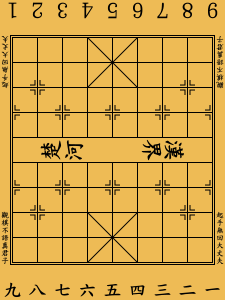Manchu chess
|
Manchu chess board and starting setup. The red chariot can also be placed on i1.[1]
|
Manchu chess[2] (Chinese: 满洲棋; pinyin: Mǎnzhōuqí[3]), also known as Yitong[4] or Yitong chess (Chinese: 一统棋; pinyin: Yìtǒngqí[5]), is a variant of xiangqi. It was created during the Qing Dynasty by the Bannermen and was one of the most popular board games among them.[6]
Rules
Black's pieces are set up and move the same as in xiangqi, but horses, cannons, and one of the chariots are absent for Red.[2][3] The remaining chariot has the combined powers of the chariot, horse, and cannon.[2][3] Although Black appears to have the advantage, the lethality of the red chariot can easily lead to an endgame if Black does not play cautiously.[3] The red chariot is believed to be the representation of Solon soldiers who were brave and battle-hardened during the Manchu conquest of China.[7]
See also
Citations
References
- Finkel, Irving L. (2007). Ancient Board Games in Perspective: Papers from the 1990 British Museum Colloquium, with Additional Contributions. British Museum Press. ISBN 9780714111537.
- Cazaux, Jean-Louis; Knowlton, Rick (2017). A World of Chess: Its Development and Variations through Centuries and Civilizations. McFarland. ISBN 9781476629018.
- Wei, Zhixin (1990). Peculiar Xiangqi Situation (象棋奇局). Shaanxi Science and Technology Press. ISBN 9787536907881.(in Chinese)
- Xu, Ke (1984). Qing Petty Matters Anthology (清稗类钞). Zhonghua Book Company.(in Chinese)

